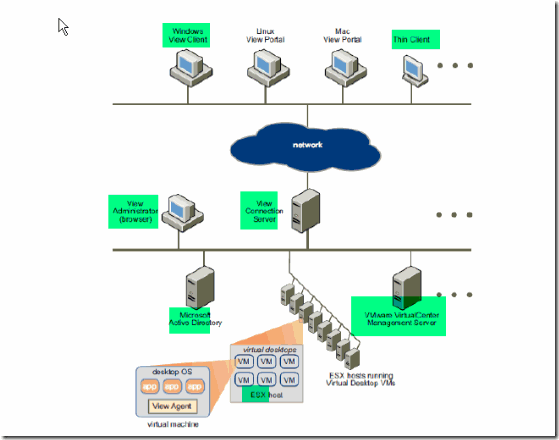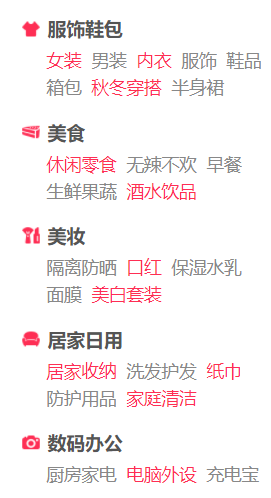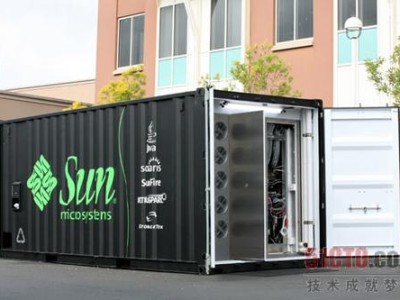一、VDI作用简要说明
对VDI更多的理解和作用还是请用GOOGLE吧。或是去微软或VMWARE的官方站点。
1、通过 Virtual Desktop Infrastructure,企业可以使用虚拟化技术在数据中心以虚拟机形式托管桌面。
2、用户可以使用远程显示协议从 PC 或瘦客户端进行访问。
二、理解微软的桌面虚拟化解决方案
微软的桌面虚拟化主要有两个方面:
1、Client-hosted类型的:以Virtual pc 2007为基础。辅助于MED-V(Microsoft Enterprise Desktop Virtualization)。
而MED-V目前还在初期阶段,据我所知的版本是V1.0。
A、MED-V environment(包含的组件,就不译成中文了,很简单的):
Host The end user’s physical computer, typically a desktop or laptop computer. It’s
also called an endpoint computer.
MED-V Client Software that runs on the host that can download and run Virtual PC
images seamlessly on the host, according to MED-V usage policies.
MED-V Image Repository An IIS Web server that stores and distributes virtual images
to endpoints.
MED-V Management Server A MED-V server that authenticates, provisions, and
controls all users of the system. Client-server communication is based on HTTP or
HTTPS.
MED-V Server The server that holds the main image repository and is the
management server.
MED-V Package A mechanism for installing Virtual PC, the MED-V client, and
optionally a virtual image on a host.
Workspace The Virtual PC image that the MED-V client runs on the host. It’s also
called a virtual machine or guest.
B、对Virtual PC 2007增强的支持:
Virtual images repository and delivery 虚拟镜像存储和分发 Simplifi es the process of creating, testing,
delivering, and updating virtual images。
Centralized management and monitoring 集中的管理和监视 Manages the life cycle of virtual images,
provisions virtual images to authenticated users according to Microsoft Active Directory users and groups, and aggregates client events for monitoring and reporting purposes。
User policy and data transfer control 用户策略和数据传输 An endpoint agent enforces usage policies and data transfer permissions on the virtual machine。
Seamless end-user experience 无缝的最终用户体验 The user remains unaware of the virtualization
running in the background and keeps one desktop environment。
2、Server-Based类型的:以Hyperv-V为基础,使用VMM2008作为管理中心。

此图就是典型的MS的VDI虚拟桌面基础架构解决方案的拓朴。可以和接下来VMWARE作一些对比。但目前应用较少,老方还没有发现在企业中的成功应用。如果有此经验者,请交流下。老方也会在较有精力时为大家奉上使用体验的系列文章,敬请观注。
三、理解VMWARE的桌面虚拟化解决方案
VMWARE的桌面虚拟化也主要有两个方面:
1、Client-hosted类型的:VMware Workstation 系列版本,实际上,老方如果不是怕VMWARE不答应也想把VMware Server给归置到此类。不过严格来说应属于服务器虚拟化范畴啦。
此软件,相信大多数朋友都有使用过的经历。此处免去介绍。
2、VMware VDI解决方案(VIEW 3.0)

VMWARE的VDI解决方案在企业中应用较为广泛:像在呼叫中心、集中访问等。
通过上述的拓朴大家就可以清楚典型的VMWARE的VIEW解决方案:客户端(连接客户端)——VDM (连接服务器)——VC——ESX SERVER。当然也可以去掉VC集中管理直接连接ESX。更直白的说就是VDM CLEINT +VDM CONNECT SERVER +VI3构成了VMWARE的虚拟桌面解决方案。
桌面池、动态池、静态池、是否分配固定桌面均是通过VDM Connect server来进行的。总之,它提供了丰富的管理功能以及两种VDM类型(网关或仅代理型)。
以上,只是简要说明了下,以使大家有个入门的了解。更详细的功能或架构还请参考官方文档。老方诚意为大家多交流关于虚拟化方面的技术及解决方案,以使在交流中进步。

 支付宝微信扫一扫,打赏作者吧~
支付宝微信扫一扫,打赏作者吧~


